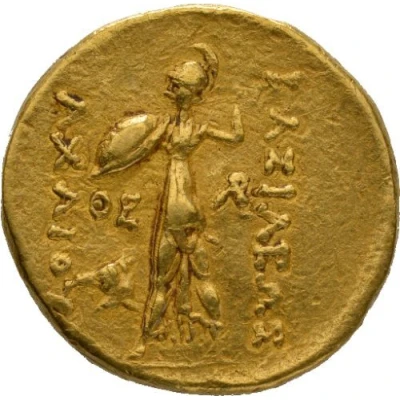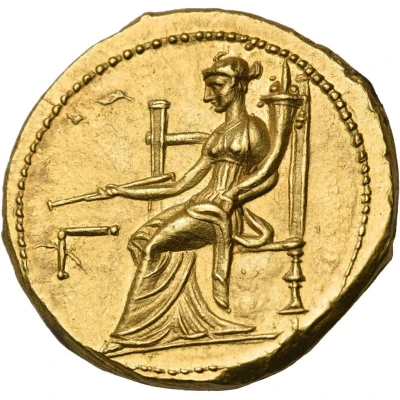


Stater - Demetrius I Soter 152 BC - 151 BC
| Gold | 8.64 g | 18 mm |
| Issuer | Seleucid Empire (Seleucid Empire (305 BC - 64 BC)) |
|---|---|
| King | Demetrios I Soter (161 BC - 150 BC) |
| Years | 152 BC - 151 BC |
| Value | Gold Stater (20) |
| Currency | Drachm |
| Composition | Gold |
| Weight | 8.64 g |
| Diameter | 18 mm |
| Shape | Round (irregular) |
| Technique | Hammered |
| Demonetized | Yes |
| Updated | 2024-10-10 |
| Numista | N#129769 |
|---|---|
| Rarity index | 100% |
Reverse
Cornucopiae oriented to left.
Script: Greek
Lettering: BAΣIΛEΩΣ ΔEMETRIOY ΣΩTHPOΣ
Comment
One of the most numismatically significant coins of the Lexington Collection, this coin is now being offered publicly, as well as being published, for the first time. This specific coin type was unknown until a handful of rare Seleucid gold coins appeared on the market in 2003. The group contained two staters of this type, struck from the same dies (the other having been sold by Classical Numismatic Group in Triton VII, 12 January 2004, lot 346), with the present example being clearly the superior of the two (the other one had a prominent flan defect on the face of Demetrius). The closest example to this type known before these two surfaced was another Demetrius/Cornucopia type struck at Antioch, but with the date SE 161 (152/1 BC) in the exergue (SC 1627). It is because of this parallel that the tentative striking date of 152/1 BC has been assigned to this coin. Houghton, Lorber, and Hoover argue in Seleucid Coins that the series struck at Antioch was an emergency issue produced by Demetrius I in the face of the challenge to his rule posed by Alexander Balas. They note that gold staters were actually produced with drachm dies, in addition to worn tetradrachm dies being employed to produce gold octodrachms (SC 1628). Furthermore, other gold denominations were produced in what they categorize as tristaters, two and a half staters, distaters, and hemistaters (SC 1629-1632). All of these gold coins were dated to SE 162, emphasizing the acute danger posed by Alexander Balas. The survival rate of these coins, however, is exceptionally low; though they have appeared in commerce over the years, not a single example of any of these Antioch gold issues has been sold publicly at last a decade.
The gold issue struck in Cilicia or Northern Syria, however, is enigmatic. Houghton et al. note that the two coins from this mint were struck from less-refined gold, suggesting "an attempt to stretch limited gold reserves" or "may simply reflect the use of unrefined gold." This, coupled with the fact that the CNG example has a planchet flaw, lead them to postulate that the minting process was hastily set up. Further evidence is the lack of a mintmark or date, suggesting the absence of an established mint administration.
Only two specimens known.



